Immerse yourself in Kumbh Mela Festival
By David Joshua Jennings
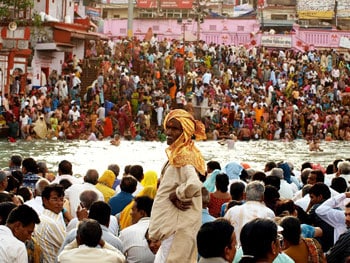
Far off through the polluted distance a 30-meter tall bronze Shiva statue lords above the scene, his colossal hand frozen in blessing. A snake the size of an oil pipeline wraps around his neck.
In the Ganges that flows nearby, splashing past like salmon, are those who have thrown themselves into the current, allowing it to sweep them between the millions of pilgrims that line the banks downriver. We are a part of Kumbh Mela, in India.
The crowds fluctuate and shimmer like jellyfish, churning and changing as they await their turn to climb down the ghat steps and lower themselves into the water.
Among these multitudes a group of policemen parts the crowd like the keel of a canoe, tweeting whistles and swinging clubs in an attempt to instill order.
An old man, perhaps eighty, little more than a skeleton, is carried past them and lowered into the river by his sons.
He gasps as the icy water swallows his body and then, as if suddenly narcotized, goes mild-eyed and limp as they hoist him up and vanish back into the crowd.
Today is full moon day, the Shakh Purnima Snan, the final and most auspicious bathing date of the Kumbh Mela, the largest religious gathering in the world.

The day has only just begun.
Morning Rituals
The morning in Haridwar has been a fine one. The air is thick with the dizzying spices of India, stirred in a cloud of aged urine and smoke, and then baked with more urine – the usual odor of the subcontinent
My girlfriend Melanie and I sit and watch as the pilgrims come in from the places they passed the night, some from government squatters’ camps, some from tents or alleyways.
Countless families simply slept on the ground alongside the Ganges.
We watch them coming down for the morning bathing ritual, and to wash their clothes. Many offer sacrifices. Nearby a woman releases an aluminum plate-boat, sagging with vegetables, into the current and makes a temple of her hands, praying as it sweeps downstream.

We walk on, heading towards the Har Ki Pauri ghat, the holiest bathing location on this most auspicious of days.
As we walk a Sadhu, a Hindu holy man, powdered with sacramental ash and naked except for a rag that dangles over his genitals, stumbles towards me with his arm outstretched.
I freeze as he approaches, allowing his hand to cling to my forehead like an octopus. The human skull around his neck swings forward and nearly touches me.
He massages my temple with his grimy fingers and chants something that sounds important, or religious, or something.
It doesn’t seem to bother him that I don’t understand what he’s saying. His breath stinks of alcohol. Then, suddenly, he stops. It’s over. He smiles, revealing his five bark-colored teeth, and extends his hand.
“Money,” he says, poking me. “Fifty rupee.”
A moment passes before I realize what has happened. “Why?” I ask in English. This causes him to waggle his head in confusion. I waggle my head back to assert my point.

I haven’t been in India for long but I’ve already grown fond of the Indian head waggle. It is a movement of the head similar to the way one moves when wiggling into tight jeans, bouncing hither and fro.
It seems they use it to mean almost anything. Currently, mine means: “I don’t understand how you think you’ve helped me. Surely I gained nothing from… whatever it is you did.” In fact, I probably would have been better off not being molested at all.
I ask him for a photograph but he recoils when I reveal my camera. He shakes his head, insisting I pay him the 50 rupees. I attempt to barter but he is not a negotiator. He is a Sadhu, and the Sadhus give a whole new meaning to the word “non-negotiator.”
The Sadhus
A Sadhu is a holy man in a land where holiness sometimes means to live in a cave without food, or to sit motionless for countless hours without food, or to generally go around doing things that require an incredible amount of obstinacy, such as standing on one foot for a decade or wandering around with an arm in the air for seven years, usually with little or no food.
The Sadhu is said to be like a candle in the center of a windless room, whose flame, immune to the stirrings of desire, flickers unwaveringly.
They seek to achieve “moksha,” liberation from the cycle of birth and death, by meditating constantly and contemplating Brahman, the birthless, deathless, immutable, infinite, immanent, transcendent reality of the universe.
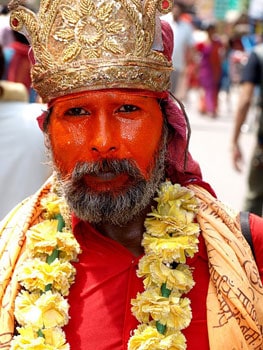
But of course every faith has its imposters – many Sadhus are simply fathers who have fled financial obligations and the hassles of raising a family. The path of the Sadhu is not pursued by many because, well, becoming a Sadhu really isn’t that practical.
The beginning step is to die, or at least die unto yourself, a process which often involves attending your own funeral. This is followed by a period of aimless wandering until a suitable guru is found.
This mentorship will usually last a few years, during which the Sadhu-in-training will perform menial, janitor-like tasks until he has absorbed enough wisdom to strike out on his own, trundling forth into an existence not unlike that of the rhinoceros: nomadic, solitary, strange.
The lifestyle is rugged. Many Sadhus rise before well before dawn to bathe in the icy mountain streams of their hermitage before settling down to mandatory, daylong prayer and meditation.
The absence of common luxuries, such as toothbrushes and homes, is a staple of the Sadhu lifestyle. But there is no single unified path that all Sadhus pursue, and in modern India the lives of Sadhus vary greatly.
Many Sadhus can be found living communally in ashrams, or alone in the caves. Others are firmly committed to a life of perpetual wandering.
If this description were applied to anyone else in the world it might seems as though they were selfish and anti-social. We would call them “bums.” Sadhus, however, occupy a unique and important position in Hindu society. They embody divinity.
They are living examples of what the human life is supposed to be about: religious illumination and transcendence. Everyday Hindus look to them for religious instruction and the bestowal of blessings.
Their austere lifestyle is seen by many as a mechanism that burns away the karma of the wider community, and for this public service they are rewarded with alms
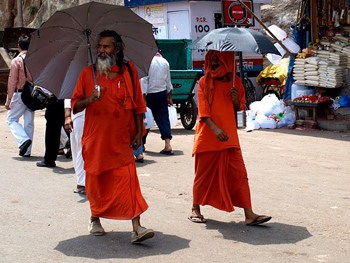
This reliance on donations, however, often means a life of continual poverty and hunger. Nevertheless, there are four or five million Sadhus in India today and nearly all of them can be found pilgrimaging during the Khumb Melas.
The one begging me for money is an Aghora Sadhu, the kind of Sadhu who lives in a graveyard and keeps company with ghosts. To attempt negotiations with such a man is surely folly. So, frustrated, I walk away, regretting it immediately.
“You should have done it,” Melanie says. “It was only a dollar. He had a human skull around his neck for God’s sake.”
He was an interesting sight, I admit.
“What did he say to you by the way? I hope he wasn’t cursing you.” She tells me about the book she’s reading. In it a naked Sadhu appears one night in front of the author’s car and curses her without reason.
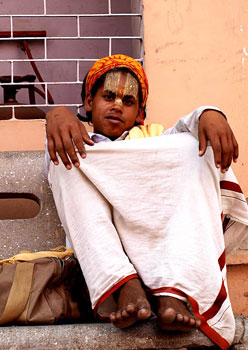
“A few weeks later she got pneumonia,” she says.
“He didn’t curse me,” I harrumph, dismissing the idea.
But inwardly I begin to worry. What if he had cursed me? After all, Aghora Sadhus are famous for the potency of their curses. Was I cursed now? Was something frightening going to occur here in Haridwar?
I turn to go back and pay him to take the curse away but the Sadhu is already being whacked off the street by police too busy to worry about curses.
Oh, the otherness of it all!
Unique things occur when wandering the cities of India, things I have experienced in no other country. One such thing strikes me as I walk down Jwalapur Road, Haridwar’s main thoroughfare.
I realize I have no idea what the buildings look like. The activity occurring at ground level is so overwhelming, so full of strangeness and color and humanity, that my gaze has rarely left the people. The background has faded into oblivion.
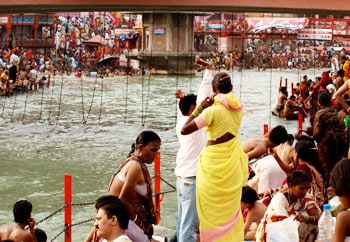
I stop and examine the buildings for what seems the first time. They look like the cushions of a neglected harem, once saffron-colored or bright red, perhaps, but now soiled, old and webbed with electrical wire.
The interior ground floors spill out into the street like a ruptured pillow. Everything in India is like this, the private in full view of the public, always greeted without scrutiny.
For instance right now a naked Sadhu is strolling by with a trident, wearing a plastic tiara that seems pilfered from some girl’s make-believe costume trunk. Nobody gives him a second look.
Advertisements for gurus cover the walls and telephone poles. These guys look like vintage porn stars, sleazy, untrustworthy. It baffles me how someone could seek such people for spiritual enlightenment. I look up and see a monkey on a phone wire above the crowded street, crawling across like a pirate.
Down an alleyway two men sit on the ground, one shaving the chin of the other. Feces falls out of a cow and slaps the ground beside them. Not far away more cows bump their heads around in trash piles searching for food. I’ve seen countless autonomous urban cows over the past weeks but it is not until this moment that I realize, by God, they graze on trash
Ignoring the rickshaws that never stop honking, fleeing the beggars that never stop following, avoiding the eyes that never stop staring, we push our way through the crowds (which never grow smaller) and enter the only air-conditioned restaurant we can find. Inside is dark and cool and full of middle-class Indians eating silently. It is like entering an igloo.
Outside in the shimmering 39-degree heat (102º F) Indian men, skinny as poles, go about their business in long-sleeved shirts and trousers, seemingly unaffected. Women walk by with enormous boxes of vegetables on their heads.
Untold numbers sleep out in the street under the hot sun. It seems Indians are able to sleep anywhere. In the last five minutes I’ve seen one snoozing: draped over the bars of his rickshaw, on top of a small carton of nuts, at the feet of a cow, right in the middle of the street.
A beggar taps on the glass, starring at me, mouthing the word “Chappatti.” One of the waiters chases him back into the heat. The cool nourishment of the monsoon will not break for another two months.
Until then most everything will remain dusty and bone dry.
Breaking bones, as well as the cycle of reincarnation
For the pilgrims, to take a dip in the Ganges today is to wash away a lifetime of sins, preparing the soul for fusion with the Oneness of the universe. Like rain drops absorbed into the ocean of eternity, as the analogy goes, breaking the cycle of reincarnation.
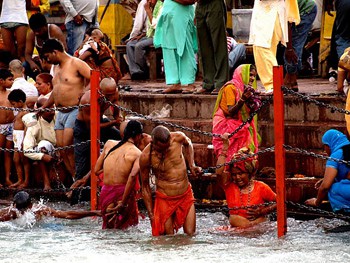
Authorities estimate that on bathing days like today roughly 100,000 people enter the water at Har Ki Pauri every hour. Imagine the amount of sin the Ganges must be dragging away!
A powerful river indeed. The reverence Indians hold for the Holy Ganga is unparalleled when it comes to worshiping natural phenomenon. They: drink it, the pray to it, bathe in it, cook with it, wash clothes in it, drop their dead in it, transport goods on it, offer sacrifices to it, and defecate in it.
And then there’s the whole washing-away-sin mechanism. To them, it is the stream that falls from heaven. To poke your finger in the Ganges is to poke your finger into eternity.
Since January, tens of millions of pilgrims have come to Haridwar by whatever means possible to experience it. Most of them are achingly poor and barefoot, fueled by little more than faith. Every bed in the city is occupied, though ninety-five percent of the pilgrims couldn’t afford one regardless.
With such overwhelming crowds safety is a serious concern. The police have tolerated no nonsense. The slightest hint of mischievousness is attacked and subdued by a barrage of wooden clubs, and for good reason too.
Two weeks ago, while the Sadhu Juna sect of holy men was marching towards the Ganges, one of its vehicles defied restrictions and ended up mowing down several people in the crowds, causing an immediate stampede. Seven people died as a result
But this was an isolated incident. The crowds for the most part regulate themselves, displaying an enormous amount of patience and mutual respect, love even, towards their fellow Hindus. After all, it is a religious festival.
Endings, beginnings, a gateway
The Kumbh Mela derives from Hindu mythology, which tells of the ancient sky-borne struggle between gods and demons over a pot, or kumbh, which contained Amrita Kalasha, the immortal nectar.
During the ferocious battle a few drops sloshed from the kumbh and fell to four locations on the Ganges: Allahabad, Ujjaink, Nashik and Haridwar. To commemorate this holy event, the Kumbh Mela is held every three years, rotating among the four cities, meaning that each hosts every 12 years.
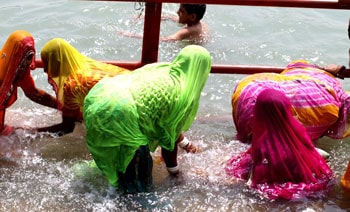
A procession pushes past us over a bridge, a few men holding a tiny body in the air, draped with ceremonial cloth, followed by a line of women trying their best not to mourn. The body is that of a dead baby.
Only in the absence of weeping will its soul be allowed to depart in peace. The poor thing probably passed at some point in the day. It does not surprise me, considering the merciless heat and the fact that I’ve seen countless people drinking jugs of polluted Ganges water.
The procession is heading towards the river, where they will weigh the baby down with a rock and lower it into the water. The bodies of the very young are not cremated. They are innocent and do not require the fire to cleanse them.
In the evening, when the air has cooled a bit and a thousands strings of light twinkle along the ghats and on the water, we make our way back towards the Ganges.
Home-made movies of the Mela play on shop televisions along the street. It is the same video burned countless times onto writable DVDs. It shows hundreds of Naga Sadhus, completely naked and covered in ash, gathered in a circle. In the center two men swing swords around in the air as if attacking invisible bees.
Occasionally they rush at each other and clang the blades together, and then fall apart, convulsing as if possessed by demons. It is the final night of the festival and these events, played over and over again, happened months ago.
Here, tucked in the foothills of the Shivalik Range, the front range of the Himalayas, Haridwar, one of the most sacred cities of India, is settling down for the evening.
Haridwar, where the glacial waters of the Ganges first reach the reach the plains. It is a gateway. The name Haridwar, or Dwar of Har, means “Gateway to God.” And the mood this night feels like that of a gateway.
We stand on a bridge and look down along the dimly lit banks, where families by the thousands are laying cloths over the cement and snuggling down, side by side, to sleep in the warm malarial air.
There is sense of closure in that air, but also one of new beginnings. Many have passed through the gate of death here over the past few months, but just as that door shuts the gate of life swings open, bringing infants, vitality, and renewal into the world.
Many are born during the festival, and many die. It is a wondrous event, the Kumbh Mela. Just being here, seeing all that humanity, all that faith, seems to bring irresistible spiritual nourishment. And it has done so for millennia.

David Joshua Jennings is an award-winning author based in Istanbul, Turkey. His short stories, travel essays, and poetry have appeared in The Windmill, Transitions Abroad, GoNomad.com and Brandt Travel, and he has contributed to two travel guides over Colombia and Venezuela.
- Shhh, Keep Quiet About Queretaro - September 30, 2024
- Wroclaw Poland: A City Full of Dwarfs - September 25, 2024
- Hoi An–A City Frozen in Time - September 19, 2024





